Wednesday, March 24, 2010
posted by Deuce Richardson
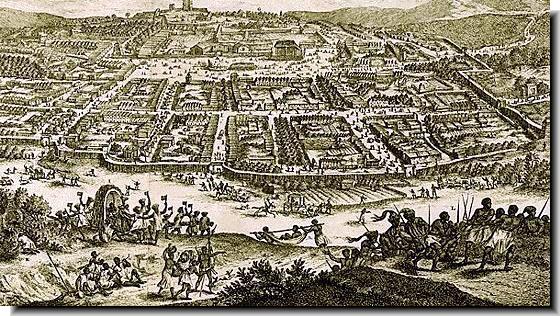
In welcome news, TC just learned that Charles R. Saunders has a fresh blog entry posted at Drums of Nyumbani, his website. The title of this post is “The First Ghana.” Much like his article, “The Epoch of Kush,” this piece by Saunders explores the rich history of sub-Saharan Africa. Another similarity betwixt the two is that both were written during the ’70s by CRS for one of the fantasy/S&S fanzines that proliferated during that decade. Fear not, Saunders’ scholarship still holds up.
Mr. Saunders reveals the history of the first Ghana (modern-day Ghana shares little but a name with its namesake). Called Aoukar by its own people, the kingdom was given its common name by Arab chroniclers, who derived it from one of the titles of the Ghanaian ruler (a situation similar to the one in which the “Inca” empire received its name from the Spanish). Reaching its height in the eleventh century AD, Ghana was a veritable sub-Saharan Klondike, exporting gold to Europe and Asia. Such riches invited envy and aggression. Eventually, Ghana succumbed.
Medieval Ghana was very likely the source of the name which REH bestowed upon the “Ghanatas” seen in the unfinished Conan yarn referred to as “The Tombalku Fragment.” Serious students of Conan the Cimmerian might also recall that he wielded a “Ghanata knife” when infiltrating black-walled Khemi in The Hour of the Dragon. Clues left by REH point to the Hyborian Age Ghanatas being a tribe situated somewhere betwixt Stygia and Tombalku, and that said tribe had notable iron-working skills. All things considered, that matches up fairly well with the Ghanatas’ (probable) historical inspiration.
I’ve been studying sub-Saharan Africa for more than twenty-five years and CRS’ post still taught me a few things. As I stated earlier, Saunders’ scholarship (like his fiction) has stood the test of time.
Friday, March 19, 2010
posted by Deuce Richardson


Those TC readers who have bothered to check the links I’ve posted in my ERB-related entries probably already suspect that I hold Bill Hillman’s ERBzine website in high regard. Such suspicions would not be unfounded. Mr. Hillman hath builded a mighty temple to the Lord of Tarzana that hangs amidst the æther in erudite splendor.
This last January, Bill presented to his readership a most excellent symposium betwixt two major Edgar Rice Burroughs fans: Richard Lupoff and Michael Chabon. Mr. Lupoff, a long-time Friend of The Cimmerian, authored the first serious look at ERB and his works, Master of Adventure, as well as editing ERB volumes for Canaveral Press. Michael Chabon (a past recipient of the Pulitzer Prize) is on record as being a fan of of Robert E. Howard and Fritz Leiber. In his ERBzine interview (conducted by Lupoff), Chabon reveals his life-long love for the fiction of Burroughs.
(Continue reading this post)
Friday, February 19, 2010
posted by Steve Trout

Howard Fast’s book Spartacus is a kind of paradox; a book about the spirit of freedom written by an avowed Communist. There are suggestions that the free slaves will share the wealth, but the main idea of the book is that all people must be free. It is subversive in a way, even today. Howard Fast, like the screen-writer for the movie, Dalton Trumble, was jailed by the House UnAmerican Activies Committee for refusing to name names. He later renounced Communism after learning of Stalin’s crimes against his own countrymen and the repression of Hungary in 1956. But Spartacus had been written in 1951, while Fast believed in Communism. Because of the political climate of the time, he had to publish it himself, with the help of friends and fans who gave him money in advance.
For an account of how he came to write Spartacus, go here.
(Continue reading this post)
Friday, February 5, 2010
posted by Steve Trout

Any of you been watching Starz’s series, Spartacus: Blood and Sand?
It’s kind of rekindled my interest in the man, and I’m reading Howard Fast’s novel and wondering what I did with my copy of the 1960 Kirk Douglas movie based on that book.
As some of you know, Howard was familiar with the story of Spartacus. In his poem, “A Son of Spartacus” he opens with a line from Reverend Elijah Kellogg’s “Spartacus to the Gladiators” speech. In Almuric you can also hear the echoes of this speech.
As someone who grew up in the age of the Comics Code, when censors suppressed Captain Kirk every time he tried to open-mouth kiss an alien girl, it’s kind of startling how much nudity, sex, violence, gore and profanity they cram into each episode. The storyline is interesting, though they’ve totally recreated Spartacus’s origin from previous versions. Although historians differ, it seems their version is more accurate than Fast’s, who has him born into slavery.
Owner of the gladiator school Batiatus is played by John Hannah, from the Mummy movies, and former warrior princess Lucy Loveless plays his scheming sexy wife. Those who want to see Xena naked are prettty much in luck. The other members of the cast are unknown to me, except for Peter Mensah, who was in 300 and Hidalgo. He plays Batiataus’ trainer.
But the acting is good.
Speaking of 300, it seems every fight is inspired by the 300 style; slow/stop/fast followed by a burst of blood, even if the blow struck would not really have produced much blood. It’s like they think 300 is the best movie ever. But I think it’s an enjoyable series so far, though I feel like a decadent Roman while watching it.
Wednesday, December 9, 2009
posted by Deuce Richardson
 Whilst the bicentennial of the nativity of Edgar Allan Poe was amply commemorated here at The Cimmerian, we somehow let the one hundred and sixtieth anniversary of his death on October 7 slip right by us. However, J. Kingston Pierce over at The Rap Sheet, one of the premiere crime-fiction blogs, was on the job. In his entry, “What Happened to Edgar?”, Pierce looks at Midnight Dreary: The Mysterious Death of Edgar Allan Poe by John Evangelist Walsh. The book was Walsh’s third foray into Poe-related historical research and he admits to being fascinated by Poe and his works. Check it out.
Whilst the bicentennial of the nativity of Edgar Allan Poe was amply commemorated here at The Cimmerian, we somehow let the one hundred and sixtieth anniversary of his death on October 7 slip right by us. However, J. Kingston Pierce over at The Rap Sheet, one of the premiere crime-fiction blogs, was on the job. In his entry, “What Happened to Edgar?”, Pierce looks at Midnight Dreary: The Mysterious Death of Edgar Allan Poe by John Evangelist Walsh. The book was Walsh’s third foray into Poe-related historical research and he admits to being fascinated by Poe and his works. Check it out.
Pierce also took a look at the shenanigans surrounding the possession of Poe’s remains, as well as the lavish commemorative celebrations sponsored by the city of Baltimore this year, in “Evermore, Mr. Poe, Evermore.” Our own Steve Tompkins also commented on the nigh-Illiadic struggle over Poe’s remains in this blog post.

Considering the size of Cross Plains in comparison to Baltimore and the relatively recent date of Robert E. Howard’s passing, I would say the organizers of Robert E. Howard Days, and REH fandom in general, have plenty to be proud of.
Wednesday, November 11, 2009
posted by Deuce Richardson
The Persian slaughtered the Apis Bull;
(Ammon-Ra is a darksome king.)
And the brain fermented beneath his skull.
(Egypt’s curse is a deathly thing.)
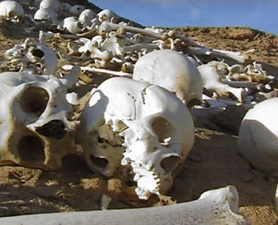
He rode on the desert raider’s track;
(Ammon-Ra is a darksome king.)
No man of his gleaming hosts came back,
And the dust winds drifted sombre and black.
(Egypt’s curse is a deathly thing.)
The eons passed on the desert land;
(Ammon-Ra is a darksome king.)
And a stranger trod the shifting sand.
(Egypt’s curse is a deathly thing.)
His idle hand disturbed the dead;
(Ammon-Ra is a darksome king.)
Til he found Cambysses’ skull of dread
Whence the frenzied brain so long had fled,
That once held terrible visions red.
(Egypt’s curse is a deathly thing.)
And an asp crawled from the dust inside
(Ammon-Ra is a darksome king.)
And the stranger fell and gibbered and died.
(Egypt’s curse is a deathly thing.)
“Skulls and Dust,” by Robert E. Howard
“No man of his gleaming hosts came back.” Indeed. What REH (and Herodotus) said. Verification of Herodotus’ tale concerning Cambyses’ lost army has been a long time coming (sort of like what Howard said about the Picts and the Basques). The archaeological findings of twin Italian brothers in the sands of the eastern Sahara might finally solve a millennia-old mystery. Naysayers have scoffed at the veracity of the Man From Halicarnassus, but they may have to rearrange their paradigms now.
(Continue reading this post)
Tuesday, November 10, 2009
posted by Deuce Richardson
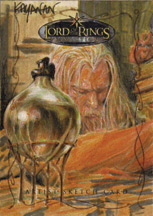
After my Tolkien post last Saturday, several interesting new insights have come to light. Wayne Hammond and Christina Scull, authors of The J.R.R. Tolkien Companion and Guide, posted this response to the Daily Telegraph article over on the J.R.R. Tolkien Collector’s Guide forum:
(Continue reading this post)
Sunday, October 25, 2009
posted by Deuce Richardson
The Battle off Samar, thus unexpectedly joined at 0648 (on October 25,1944), was the most remarkable of the Pacific war, since the tactics had to be improvised.
–Samuel Eliot Morison, from The Two-Ocean War
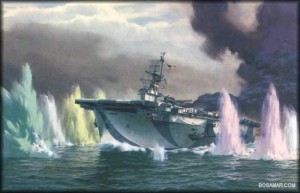
It was difficult deciding what battle to commemorate today. I finally settled on the Battle off Samar for several reasons. One reason is that it was just one helluva scrap. Another being that Samar, and the Battle of Leyte Gulf which encompassed it, is largely neglected and/or forgotten, even by many who consider themselves “World War Two buffs,” this despite the fact that the events centered upon the Gulf of Leyte ended up breaking the Imperial Japanese Navy. The awe-inspiring bravery of the men at Samar warrants remembrance on this sixty-fifth anniversary of the battle. (Continue reading this post)
Sunday, October 25, 2009
posted by Deuce Richardson
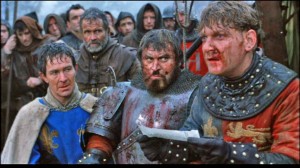
Enter the OE, bookmarking his place in “The Black Stranger”:
Rather proclaim it, Doc Pod, online and off,
That he which hath no ideas for this Mailing,
Let him gafiate; his name from the roster stricken,
And dues refunded put into his man-purse;
We would not zine in that fan’s company
That spares not his weekend to zine with us.
This day is call’d the feast of [Tim] Marion,
He that outlives this day, and comes safe to #201,
Will stand a tip-toe when this Mailing is nam’d,
And rouse him at the thought of August of ‘06
He that shall zine this day, and live to look like Burl Ives,
Will quarterly one night neglect the remote,
And say ‘Twas not always but a single section.’
Then will he fetch his stacks and show his zines,
And say ‘These printing problems I had in Mailing #200.’
All shall be Mylared; or sold off on eBay,
But he’ll remember, with advantages,
What pages he filled that day. Then shall our names,
Familiar in his mouth as usual suspects —
Indy the OE, Rippke and Trout-in-the-Dark,
Richter and Gramlich, Romeo and Sea-Burke
Be in their flowing cups beerily remembered.
This story shall the good fan teach his son;
And deadlines shall ne’er force FedEx,
From this Mailing to the ending of the world,
But we in it shall be remembered —
We few, we serconn’d few, we apa of brothers;
For he today that sheds his ink with me
Shall be my brother; be he ne’er so minacked,
This day shall excuse his reprint;
And gentlefans at innercircle now-a-bed
Shall think themselves accurs’d they were not here,
And hold their manhoods cheap while any speaks
That zined with us for Mailing #200.
The above was penned by Steve Tompkins on July 25th, 2006, exhorting his REHupan brethren in Bard of Avonic fashion to make the heroic effort that culminated in REHupa Mailing #200.
It seems hard for me to believe that Tompk posted that tribute to King Harry’s pre-game speech as given on the morn of the Battle of Agincourt (as envisioned by Shakespeare) without being aware that he was doing so on the twenty-fifth of July. Steve Tompkins was nothing if not mindful of the passing of time and of the importance of observing anniversaries. He was certainly capable of seeing unlikely, but fitting, connections. (Continue reading this post)
Friday, September 25, 2009
posted by Deuce Richardson
One of the most significant archaeological discoveries ever made on British soil was announced this week. The news? An amateur treasure-hunter in western Staffordshire recently discovered an Anglo-Saxon hoard of unprecedented size and richness. The location of the “Staffordshire hoard” (dated to the half-century betwixt 675 and 725AD) places it within the north-western boundaries of the Dark Age Saxon kingdom of Mercia.
J.R.R. Tolkien was deeply interested in the history of Mercia. He traced his maternal (and much of his paternal) line back to that realm. Tolkien spent almost all of his childhood within the bounds of the now-vanished kingdom. He is known to have stated that he felt a sense of instant familiarity and kinship with the distinctive Mercian dialect of Old English when he first encountered it, early on in his philological studies. A good deal of The Book of Lost Tales was localized within what was Mercian territory. He even seems to have believed that Beowulf, possibly the one work of literature closest to his heart, was composed in Mercia at roughly the time that the “Staffordshire hoard” seems to have been inhumed.
Mercia itself ought to be known in some degree by anyone who is familiar with Tolkien’s legendarium. It can be seen, in a very fantasticated form (in much the same way that REH’s envisioning of medieval Ireland resembles Hyborian Age Cimmeria) in The Lord of the Rings. Namely, Rohan; or, as the Eorlingas themselves called it: the Riddermark. Riddermark. “The ‘Mark’ of the Horsemen.” The word “mark” in this instance is derived by JRRT from the Anglo-Saxon word “mearc” (the basis, ultimately, for the name, “Mercia”) which is itself sprung from an even older term for “line or boundary.” By linguistic extension, that noun in Anglo-Saxon came to mean “border” or “frontier” (though only its more common and primal sense survived into modern English). Words such as “marquis,” “Denmark” and “march” (as in the sense of a “Bossonian March”) fossilize this archaic meaning like ancient beasts in amber.
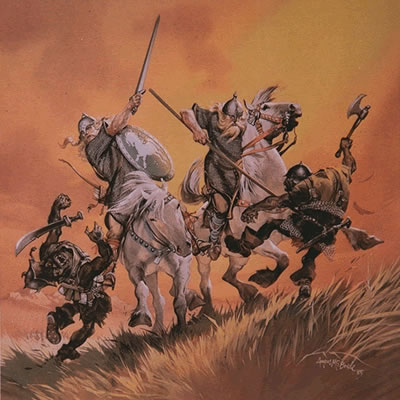
(Continue reading this post)






 Whilst the bicentennial of the nativity of Edgar Allan Poe was
Whilst the bicentennial of the nativity of Edgar Allan Poe was 








